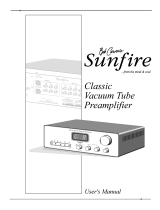
20
The McIntosh engineering staff has created a Tube
Preamplifier without compromise, using the most
advanced McIntosh circuit design concepts. Many
months of design, testing and measuring were re-
quired. Extensive controlled listening tests, the ulti-
mate form of measuring, were made before the final
design was accepted.
Silent Audio Switching
All signal switching in the C2300 is done by Electro-
Magnetic devices. Electro-Magnetic Switching is a
proven technology that uses the latest in materials
and manufacturing methods. Each switch consists of
a glass tube that is filled with an inert oxygen-free
atmosphere and sealed with tiny leads protruding
from either end. These leads extend into the tube and
overlap one another with a separation of a few thou-
sandths of an inch. The leads are made from a ferrous
material that is influenced by a magnetic field. They
are first plated with gold as a base material, then with
rhodium and finally ruthe-
nium. Ruthenium is the best
contact material known.
Refer to figure 28.
The glass assembly is then
placed in the center of a
multilayer coil of copper
wire. The entire assembly
is molded together in a tough shock absorbing mate-
rial. The switch and coil connectors extend from the
bottom in the form of printed circuit board terminals.
When a DC voltage is applied to the coil, current
flows and creates a magnetic field. The force of the
field causes the leads to bend and contact one another
inside the sealed glass tube. The inert gas eliminates
corrosion of the contacts and insures a low resistance,
distortion free switch.
All inputs, outputs, and data ports are controlled
by logic circuits in the C2300. The logic is changed
by Front Panel Push-buttons or by a microproces-
sor IR decoder. This microprocessor IR decoder is
programmed with exclusive McIntosh software. It
receives data from the Front Panel or Sensors and pro-
vides the command signals for input switching, data
switching, tone control and volume control.
Phono Circuitry
McIntosh has long been known for its expertise in low
noise discrete amplifier circuits. The MC Amplifier
consists of two stages, which together have a gain of
60dB at 1000Hz. The first stage (pre-preamplifier) is
a new design Moving Coil Preamplifier using special
ultra low noise circuitry with out the need for a step-
up transformer. It offers the ability to change the input
impedance from 25 ohms to 1000 ohms in six steps to
match a wide variety of Moving Coil Cartridges. The
C2300 utilizes a double filtered power supply design,
just for the Moving Coil Preamplifier.
The second (compensation) amplifier stage uses
12AX7A tubes. Its input stage has been optimized for
low noise and low distortion performance. With high
open loop gain, negative feedback is used around the
Phono Amplifier to further reduce noise, distortion
and has a very wide dynamic range. The feedback
network also provides precision RIAA frequency
compensation. The output is buffered by a unity gain
amplifier for low output impedance.
The MM Phono Amplifier uses 12AX7A tubes. Its
input stage has been optimized for low noise and low
distortion performance. It offers the ability to change
the load capacitance from 50 pF to 750 pF in 50 pF
steps to match a wide variety of Moving Magnet Car-
tridges. With high open loop gain, negative feedback
is used around the Phono Amplifier to further reduce
noise, distortion and has a very wide dynamic range.
The feedback network also provides precision RIAA
frequency compensation. The output is buffered by a
unity gain amplifier for low output impedance.
Tone Control Circuitry
A control attenuator inserts a series tuned circuit into
either the feedback or input section of the tone ampli-
fier. The level is set by a digitally controlled electronic
attenuator. This provides a 12dB boost or cut in 1dB
steps at the frequency of the tuned circuit. The Bass
turn-over frequency is 200Hz. The Treble turn-over
frequency is 2kHz. The overall gain of the stage is
0dB when the tone is adjusted to flat. The TONE
BYPASS switch removes all tone control circuits from
the signal path.
Volume Adjustments
The most frequently operated control on a Preampli-
fier is the Volume Control. So it is no surprise that
McIntosh has devoted a substantial amount of time in
pursuit of the “Perfect Volume Control System”.
Conventional Mechanical Controls have poor
tracking especially when it comes to maintaining
channel balance and after a period of time they tend
to introduce noise into the audio signal, as they are
rotated. The one desirable thing they have is the rate
of change in volume for degrees of rotation, known as
the audio taper. Using Electronic Circuitry for control-
ling, the volume can be designed to be free from noise
and maintain channel balance, however the audio
Technical Description
Figure 28

























